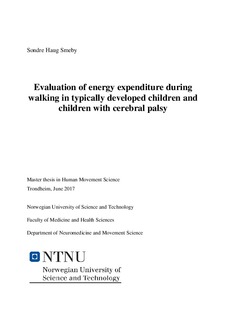| dc.description.abstract | Background: Cerebral palsy (CP) is caused by a lesion in the brain before, during or shortly after birth and can lead to activity limitations. Children with CP generally walk slower and have higher energy expenditure (EE) than typically developed (TD) children. EE and energy cost (EC) can say something about how physically demanding walking is for an individual. Finding out how age, gender and walking speed affects EE and EC in TD and CP children is desirable.
Aim: The overall aim of this master thesis was to gain more insight in the evaluation of EE and EC during walking in TD children and children with CP. The specific aim of this thesis was twofold; First, to evaluate the effect of age, gender and walking speed on EE and EC. Second, to investigate differences in the effect of walking speed on EE and EC between well-functioning children with CP and TD children.
Method: Forty-four TD children (age 7 - 15) and five CP children (age 8 - 17) with GMFCS level 1 performed three 3-5 minutes walking tests on self-selected slow, normal and fast walking speed wearing portable indirect calerometry equipment (Metamax II). VO2 and respiratory exchange ratio (RER) were extracted from a 1-minute period of steady state. Distance travelled during the same period was also measured and used to calculate walking speed. Together with body weight these measures were used to calculate EE and EC.
Results: EE and EC both decreased with age (p < 0.001), EE increased with walking speed (p < 0.001), EC decreased with walking speed (p < 0.001), but there were no gender effects (EE p = 0.4 and EC p = 0.6) in TD children. The CP group had very similar EE and EC values compared to the TD group (all differences had a p > 0.7). Also the change in EE and EC with walking speed was similar in CP compared to TD.
Conclusion: Both EE and EC decreases with age in TD children, while they are not dependent on gender. EE increases with higher walking speed for both TD and CP, but within each speed instruction the differences in chosen walking speed between the participants on average gives the same EE. EC is higher during slow walking speed compared to normal and high walking speed in both TD and CP. | nb_NO |
